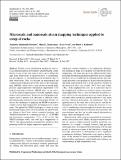Microscale and nanoscale strain mapping techniques applied to creep of rocks
Author(s)
Quintanilla-Terminel, Alejandra; Zimmerman, Mark E.; Evans, Brian; Kohlstedt, David L.
Downloadse-8-751-2017.pdf (21.25Mb)
PUBLISHER_CC
Publisher with Creative Commons License
Creative Commons Attribution
Terms of use
Metadata
Show full item recordAbstract
Usually several deformation mechanisms interact to accommodate plastic deformation. Quantifying the contribution of each to the total strain is necessary to bridge the gaps from observations of microstructures, to geomechanical descriptions, to extrapolating from laboratory data to field observations. Here, we describe the experimental and computational techniques involved in microscale strain mapping (MSSM), which allows strain produced during highpressure, high-temperature deformation experiments to be tracked with high resolution. MSSM relies on the analysis of the relative displacement of initially regularly spaced markers after deformation. We present two lithography techniques used to pattern rock substrates at different scales: photolithography and electron-beam lithography. Further, we discuss the challenges of applying the MSSM technique to samples used in high-temperature and high-pressure experiments. We applied the MSSM technique to a study of strain partitioning during creep of Carrara marble and grain boundary sliding in San Carlos olivine, synthetic forsterite, and Solnhofen limestone at a confining pressure, P c , of 300MPa and homologous temperatures, T =T m , of 0.3 to 0.6. The MSSM technique works very well up to temperatures of 700 °C. The experimental developments described here show promising results for higher-temperature applications.
Date issued
2017-07Department
Massachusetts Institute of Technology. Department of Earth, Atmospheric, and Planetary SciencesJournal
Solid Earth
Publisher
Copernicus GmbH
Citation
Quintanilla-Terminel, Alejandra et al. “Microscale and Nanoscale Strain Mapping Techniques Applied to Creep of Rocks.” Solid Earth 8, 4 (July 2017): 751–765. © 2017 Author(s)
Version: Final published version
ISSN
1869-9529